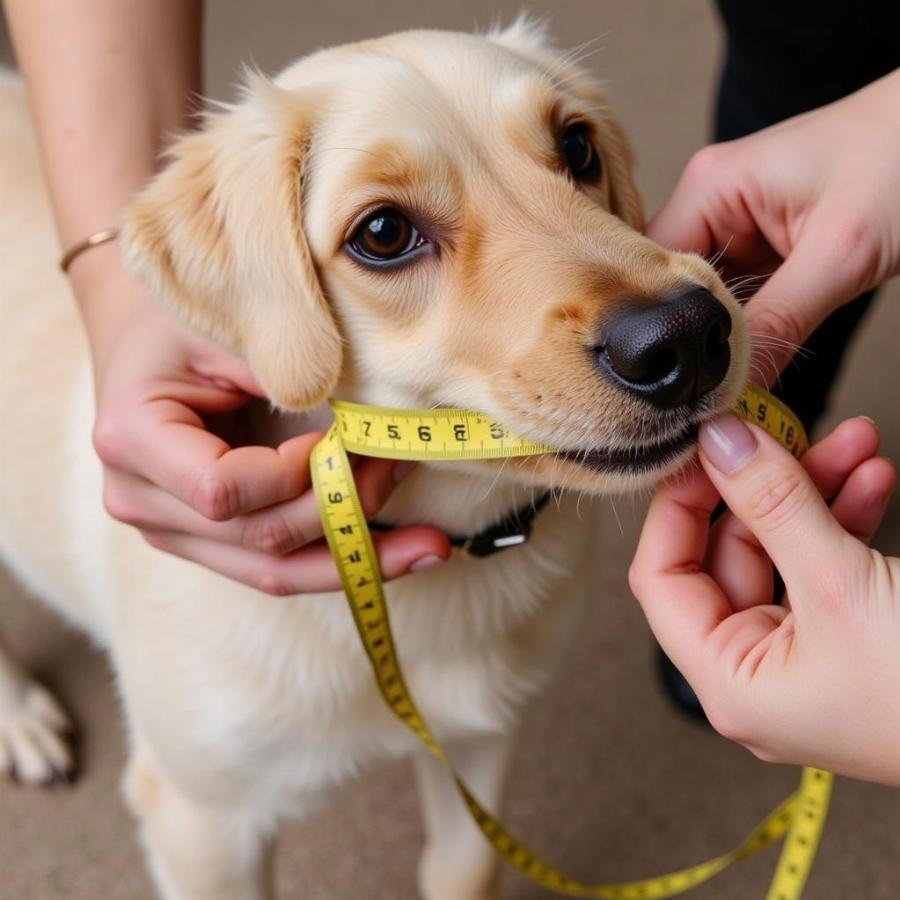A properly fitted muzzle is essential for your dog’s comfort and safety. Knowing how to measure your dog for a muzzle correctly ensures a secure fit that allows for panting, drinking, and even treating, while preventing biting or unwanted scavenging. An ill-fitting muzzle can cause discomfort, anxiety, and even injury, so accurate measurements are crucial. This guide will walk you through the steps of how to measure your dog for a muzzle, ensuring a perfect fit for your furry friend.
Understanding the Importance of Correct Muzzle Measurements
Choosing the right muzzle size is not just about comfort; it’s about your dog’s well-being. A muzzle that’s too tight restricts breathing and panting, which can be dangerous, especially in warm weather. A muzzle that’s too loose, however, defeats its purpose, allowing your dog to bite or pick up things they shouldn’t. Understanding how to measure your dog for a muzzle ensures their safety and comfort.
 Measuring a dog for a muzzle
Measuring a dog for a muzzle
Key Measurements for a Perfect Muzzle Fit
There are several key measurements you’ll need to take to ensure a proper muzzle fit. These measurements include:
- Circumference: This is the measurement around your dog’s snout, about an inch below their eyes. This is the most important measurement for determining the correct muzzle size.
- Length: Measure from the tip of your dog’s nose to just below their eyes. This measurement ensures the muzzle isn’t too long or too short.
- Width: Measure across the widest part of your dog’s snout. This measurement helps ensure the muzzle isn’t too narrow, allowing for comfortable panting and drinking.
- Height: Measure from the top of your dog’s nose to their chin. This ensures the muzzle provides adequate coverage while still allowing for comfortable mouth movement.
Step-by-Step Guide: How to Measure Your Dog for a Muzzle
Follow these steps to accurately measure your dog for a muzzle:
- Prepare your dog: Make sure your dog is calm and relaxed. Use positive reinforcement and treats to make the experience positive.
- Use a flexible measuring tape: A soft, flexible measuring tape is essential for accurate measurements. Avoid using a rigid ruler or metal tape measure.
- Measure the circumference: Gently wrap the tape measure around your dog’s snout, about an inch below their eyes. Make sure the tape measure is snug but not tight.
- Measure the length: Measure from the tip of your dog’s nose to just below their eyes.
- Measure the width: Measure across the widest part of your dog’s snout.
- Measure the height: Measure from the top of your dog’s nose to their chin.
- Record your measurements: Write down all your measurements, being sure to label each one clearly.
Choosing the Right Muzzle Based on Your Measurements
Once you have your dog’s measurements, refer to the sizing chart provided by the muzzle manufacturer. Each brand may have slightly different sizing, so it’s important to use their specific chart. Don’t rely solely on breed or weight recommendations, as individual dogs can vary significantly in size. If your dog’s measurements fall between sizes, choose the larger size to ensure a comfortable fit. muzzle for a shih tzu dog
Common Mistakes to Avoid When Measuring for a Muzzle
- Measuring too tightly: This can lead to a muzzle that is too small and restricts breathing.
- Using a rigid measuring tape: A rigid tape measure can be inaccurate and uncomfortable for your dog.
- Not accounting for fur: For long-haired breeds, be sure to account for the thickness of their fur when taking measurements.
- Relying solely on breed or weight: Individual dogs can vary in size, even within the same breed. Always take accurate measurements.
Expert Insights on Muzzle Fitting
Dr. Emily Carter, a renowned veterinary behaviorist, emphasizes the importance of proper muzzle fitting: “A well-fitted muzzle should allow a dog to pant, drink, and take treats, while still preventing biting. It should never restrict breathing or cause discomfort.” Dr. Carter also advises introducing the muzzle gradually and using positive reinforcement to create a positive association. Another expert, Jane Miller, a certified dog trainer, adds: “Accurate measurement is just the first step. Training your dog to accept and wear the muzzle comfortably is equally important.” dog collar for large dogs
Conclusion
Measuring your dog for a muzzle correctly is crucial for their safety, comfort, and well-being. By following the steps outlined in this guide and avoiding common mistakes, you can ensure a perfect fit that allows your dog to breathe easily, drink comfortably, and even enjoy treats while preventing unwanted behaviors. dogs who kill cats
FAQ:
- Why is it important to measure my dog for a muzzle? Accurate measurements ensure a comfortable and safe fit, allowing your dog to pant and drink while preventing biting.
- What type of measuring tape should I use? Use a soft, flexible measuring tape.
- What should I do if my dog’s measurements fall between sizes? Choose the larger size.
- How can I make the measuring process more comfortable for my dog? Use positive reinforcement and treats.
- Where can I find a muzzle sizing chart? Refer to the sizing chart provided by the muzzle manufacturer.
- What should I do if my dog resists the muzzle? Introduce the muzzle gradually and use positive reinforcement.
- Can a muzzle be harmful to my dog? An ill-fitting muzzle can be harmful, so accurate measurements are crucial.
Further Reading:
Do you have concerns about poison ivy affecting your dog? Check out our article on poison ivy in dogs. If your dog has encountered a porcupine, you might find our guide on porcupine quills dog helpful.
Beaut Dogs is your trusted resource for all things dog-related, offering expert advice and information on various breeds, care tips, and product recommendations. When you need assistance, contact us at [email protected] (Email address) for detailed and accurate answers. Beaut Dogs is committed to helping you provide the best possible care for your canine companion.